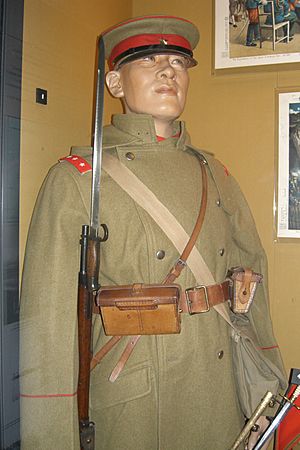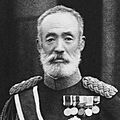Imperial Japanese Army facts for kids
Quick facts for kids Imperial Japanese Army大日本帝國陸軍 Dai-Nippon Teikoku Rikugun |
|
|---|---|

The ensign of the Imperial Japanese Army
|
|
| Active | 1868–1945 |
| Country | |
| Allegiance | |
| Type | Army |
| Role | Military ground force |
| Size | 6,095,000 men at peak |
| Nickname(s) | "IJA" |
| Engagements |
|
| Commanders | |
| Ceremonial chief | Emperor of Japan Emperor Meiji Emperor Taishō Emperor Shōwa |
| Notable commanders |
Yamagata Aritomo Ōyama Iwao Prince Kan'in Kotohito Hajime Sugiyama Hideki Tojo Yasuji Okamura Shunroku Hata Tadamichi Kuribayashi Tomoyuki Yamashita Masaharu Homma |
The Imperial Japanese Army (IJA) was Japan's main ground fighting force. It existed from 1868 to 1945. Its full name in Japanese was Dai-Nippon Teikoku Rikugun, meaning "Army of the Greater Japanese Empire."
The IJA was controlled by the Imperial Japanese Army General Staff Office and the Ministry of War. Both of these groups reported to the Emperor of Japan. The Emperor was the supreme commander of both the army and the navy. The IJA played a big role in Japan's history, especially during World War II.
How the Army Started (1868-1871)
In the mid-1800s, Japan did not have one single national army. The country was divided into many small areas called han, which were like feudal states. The Tokugawa shogunate had ruled Japan since 1603. Their army was large, but they needed help from other local armies to control the country.
Japan had been mostly closed off from the world for two centuries. When it opened up, it led to big changes. This included the Meiji Restoration and the Boshin War in 1868. After these events, Japan decided to create a modern, unified army.
The Imperial Japanese Army was officially ended at the end of World War II. Today, Japan's constitution has a rule, Article 9. This rule says that Japan cannot use military force to solve problems with other countries.
Joining the Army
In 1873, a new law was passed about joining the military. This law made it mandatory for all men in Japan to serve in the army.
The law said that men had to serve for a total of seven years. This included three years in the regular army, two years in the first reserve, and two more years in the second reserve. All healthy men between 17 and 40 years old were also part of a national guard. This group would only be called to serve if Japan was attacked or invaded.
Images for kids
-
Prince Yamagata Aritomo, a field marshal in the Imperial Japanese Army. He was also Prime Minister of Japan twice. He helped build Japan's modern military.
-
Marquis Nozu Michitsura, an early field marshal in the Imperial Japanese Army. He became chief of staff of the Imperial Guard (Japan) in 1874.
-
Marquis Jutoku Saigo, a general in the early Imperial Japanese Army. He was the nephew of Saigō Takamori, who led the Satsuma Rebellion in 1877.
-
Count Nogi Maresuke, a general in the Imperial Japanese Army and the third governor of Taiwan.
-
Count Akiyama Yoshifuru, who led cavalry in the First Sino-Japanese War (1894–1895). In the Russo-Japanese War (1904–1905), he fought against Russian cavalry.
-
Prince Katsura Tarō, who was Prime Minister of Japan three times. He was the Vice-Minister of War and commanded the IJA 3rd Division during the First Sino-Japanese War.
-
Officers of the Allied Military Mission in Siberia, Vladivostok, during the Siberian Intervention.
See also
 In Spanish: Ejército Imperial Japonés para niños
In Spanish: Ejército Imperial Japonés para niños


























